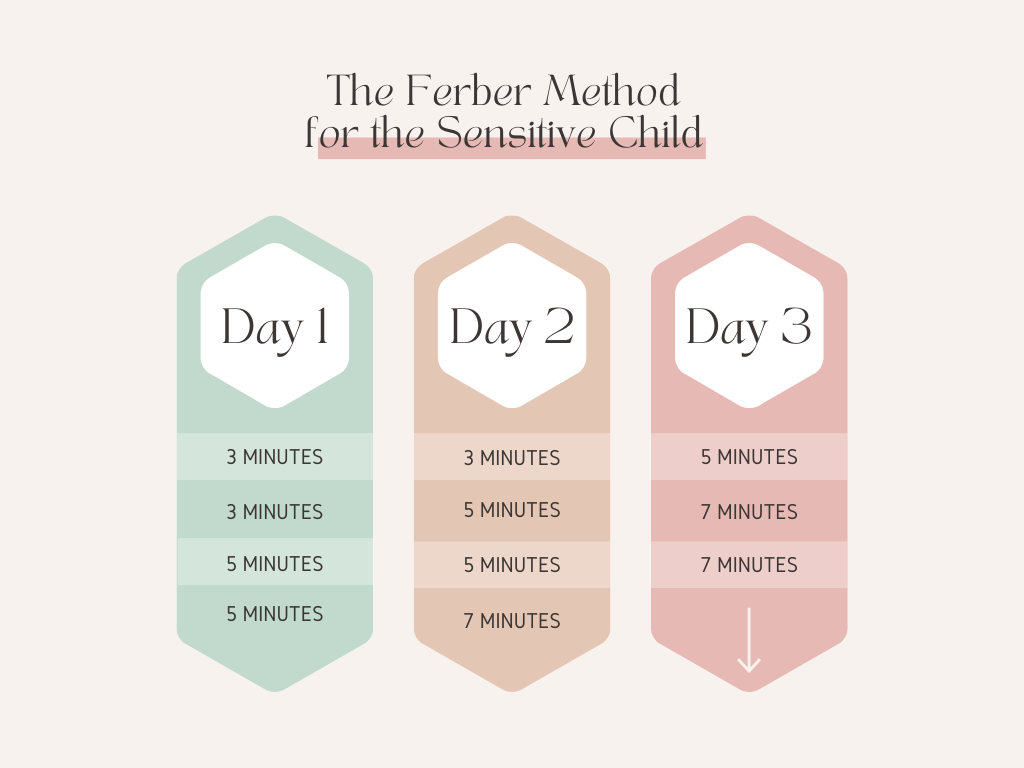I knew having a baby would be hard, but I never imagined it’d be like living in another dimension where sweet, little screaming creatures mentally break you and then smile.
Ever since I gave birth, I have obsessed over my child’s sleep, along with countless other parents.
On top of raging hormones, you’re awake every two to three hours. If that bottle is not made, your baby is screaming bloody murder to eat. If you’re strictly breastfeeding, it may very well be the most painful and exhausting experience you’ve ever been through, which I get into more here where I share some tips on boobie self-care.
I anticipated a lack of sleep with a newborn. What I didn’t anticipate was our daughter going into months three, four, six, and eight— and had only slept through the night for one consecutive week since she was born.
However, the bottom line is almost half of babies DO NOT sleep through the night, especially breastfed babies. Experts consider sleeping through the night as sleeping between 6-8 hours straight overnight.
Pennestri 2018 et al., as cited in McCarthy 2018
I know. This doesn’t help your situation, but there IS a light at the end of the tunnel.
Our daughter was an insomniac baby and at 13 months started sleeping from 7:30 p.m. to 6:15 a.m. Now at two years old, she sleeps from 7:30 p.m. to 7:00 a.m.
It took a few trials and errors to get here but my hope is it’ll be quicker and easier for you after you’ve read this post.
Pediatricians recommend waiting until four months to sleep train, HOWEVER, I do not recommend attempting to sleep train during any regressions or big changes. Between 3-4 months is generally when your baby’s sleep cycle shifts. Attempting to sleep train during this time may prove to be counterproductive. Just continue to create good sleeping habits.
SLEEP TRAINING TRIALS
At first, I was adamant about not sleep training.
One, because I refused to shell out hundreds of dollars for a sleep training course.
Two, I’m a controlling first-time mom and wanted to do it on my own.
Three, deep down, no matter what anyone else said to me, I believed it was NORMAL for babies NOT to sleep.
Then motherhood got real, REAL quick.
FOUR MONTHS
Four-month sleep was TERRIBLE.
This is when I began to overuse the dreaded word “regression” to explain to everyone why our baby wasn’t sleeping. Our daughter refused naps and wouldn’t sleep at night either. I have no idea how she functioned because she was still generally happy during the day.
I was losing it and she was happy as a clam.
Four-month sleep regression is one of the most difficult, so give yourself some grace.
During this time, we tried the S.I.T.B.A.C.K method. Again, I do not recommend continuing anything new (if it’s not working) between 3-4 months when your baby is in the midst of a major sleep shift. In a nutshell, the S.I.T.B.A.C.K. method is when your baby falls asleep, you leave the room. When they wake up in the middle of the night, you sit back down in a chair until they fall asleep again. Every few nights, you move the chair further and further away until you’re out of the room.
If we weren’t in view or holding our daughter’s tiny hand, she’d cry— so we took turns rocking her to sleep. If that didn’t work, I’d nurse her to sleep, which was almost always the case. We had to do this at bedtime and when she would wake up three to four times in the middle of the night.
Don’t make the mistake of expecting this method to work as a way to get your child to go back to sleep.
This method is best used early on to lay a foundation for good sleeping habits. It’s called sleep training for a reason.
You’re teaching your baby, who was in a safe, small space in your belly for nine months, how to learn a completely new skill. Think of your baby as an alien, albeit a cute one, who knows nothing of this planet. Everything is new to them, even the rhythm of day versus night.
As mentioned above, parents often try to sleep train at 4 months because this is when pediatricians give the green light, but it could also be the absolute worst possible time to sleep train. Our daughter was not having it and neither were we, so I waited to try sleep train again.
However, I wish I hadn’t waited until she was 9 months old. Follow your baby’s lead and see what works for you and your baby.
9 MONTHS
After a ton of searching on Google and talking to a few friends, I tried the Cry-It-Out method.
I was desperate. We had just gone through a hectic moving process and since she had a cold, we didn’t set her crib up immediately. We let her sleep in bed with us for two weeks. It was AWFUL. Our daughter nursed ALL NIGHT LONG. It was like newborn sleep all over again. Once we got her back in her crib, her sleep was back to normal, which was waking up anywhere between 1-3 times in the middle of the night. We decided (or I thought we had decided) to try the Cry-It-Out Method after she woke up five times one night.
We let her cry for 45 mins. I clenched my teeth, and my boyfriend and I argued as she screamed, but I stood my ground. He wanted me to go to her nursery, like I did every single night, and nurse her back to sleep. I was at my wit’s end.
I finally did nurse her back to sleep and we never tried the CIO method again.
This is before I knew breastfed babies may still need 1-2 middle of the night feedings up to a year old AND before I knew sleeping through the night equated to 6-8 hours.
I thought sleeping through the night meant she would not wake to eat at all. Several mom blogs said a baby shouldn’t need to wake up to eat at 9 months, even breastfed babies. Yes, we had discussed it with her pediatrician first but when he said she should be sleeping through the night by 9 months, he meant anywhere from 6-8 hours, not straight through overnight.
Maybe this is common sense for some parents, but I was a new mom, during a pandemic, with a baby screaming the entire time at her doctor appointments. Sleeping through the night sounds like, THROUGH THE NIGHT. I felt horrible. I let my baby cry for 45 mins when she was probably just hungry.
There’s a ton of conflicting information out there, even by the experts, on night wakings and baby sleep. Your child’s pediatrician may say something different than what my daughter’s pediatrician said.
I made my decision to try the Cry-It-Out-Method after months of no sleep, barely able to function for a full eight hours working from home with her, and my relationship with my partner was suffering. I was suffering. Sound familiar?
Unfortunately, there is no concrete answer because ALL BABIES ARE DIFFERENT. The goal is to try different ways to create a foundation for good sleeping habits so you can still get some sleep, for example, breaking sleep associations. Do you nurse your baby to sleep? Do you rock your baby to sleep? These are a part of their sleep routine and there’s no problem with the associations if you and your baby are okay with it, but your baby may wake up in the middle of the night and need you to help them fall back asleep.
There’s a serious misconception about baby sleep and although I adapted Dr. Ferber’s method to sleep train my daughter, I would never recommend night-weaning at 3 months old, especially for breastfed babies.
I spent months writing and rewriting this post because I spent hours reading scholarly journals to use current, research-based evidence. From what I’ve gathered, breastfed babies may still wake up for 1-2 feedings until 12 months of age.
The good news is, you can still sleep train even if your baby still needs to wake up to eat! Our daughter consistently woke up 45 mins after we put her down for bed. When we sleep-trained, that stopped! That alone was a huge win for us!
The Ferber Method
Since I couldn’t handle going through the CIO method again and wanted to still sleep train, I tried the Ferber method.
You put your baby down in their crib drowsy but still awake, and leave the room. If your baby cries, you check in on them periodically until they fall asleep on their own. For example, Day 1 will look like this.
1st Check: 3 minutes
2nd Check: 5 minutes
3rd Check: 10 minutes
4th Check: 10 minutes
You then continue to check on your baby every 10 minutes until they fall asleep. Every day, you gradually increase the time lapsed between each check.
It wasn’t easy. Our daughter screamed bloody murder. When one of us would check on her, she was sobbing hysterically. I can’t remember how long it took for it to work, but I know it wasn’t more than three days.
We couldn’t believe it!
She still woke up around midnight and between 4:30 and 5:30 am. to eat, however, this was a HUGE win for several reasons:
- I didn’t have to nurse her to sleep.
- She went down awake but drowsy and was HAPPY.
- Her father could put her to bed too (after I nursed her in the living room, NOT her bedroom).
- She didn’t wake up 45 minutes after bedtime. This was a BIG one. She woke up consistently every night a short time after putting her down for bed and this disappeared.
- When she’d wake to breastfeed 1-2 times in the middle of the night, she’d go back down in her crib awake, but drowsy, without a fight.
Then a month later my daughter contracted a bad cold so this was short-lived, BUT the main takeaway is that the Ferber Method worked.
It’s important to note if you’re trying to wean the nighttime feedings, you should consult with your child’s pediatrician first. Always keep in mind the recommended amount of nighttime feedings based on your child’s age and whether they’re breastfed or formula-fed. Check out my post here dedicated to night weaning!
Then my daughter contracted a bad cold and my efforts went out the window.
12 MONTHS
She was sick for weeks in October, got better, and then caught the stomach flu in December.
I was nursing her to sleep and she was waking up anywhere between two to four times in the night. Looking back at my Mom’s One Line A Day journal, I obsessed over her naps and the temperature of the room. Even though she never wore a sleeper, I tried this too.
I put sleep training in the back of my mind because although it had worked within 3 days previously, it was so difficult and the mom’s guilt had been horrible.
From November to the beginning of January I felt like I was doing a study on my child.
I started thinking her second nap was interrupting her getting a full night’s sleep, but it didn’t matter. There were times she would have a long afternoon nap, sleep until 5 pm, and she would sleep through the night. My inconsistent research was a haphazard way of trying to gain back control.
Then one night she woke up five times and I had enough.
I decided to sleep train again while also weaning her from the nighttime feedings since she was almost 13 months old. I dedicated a post specifically to night weaning here.
FERBER METHOD FOR THE SPIRITED CHILD
The last time we tried the Ferber Method it was difficult for us and our daughter, so I changed our time interval to work for our spirited child. If your baby screams bloody murder like mine, this method may work better for their needs versus continuing to increase the time.

On DAY 1 we didn’t go over five minutes, and on DAY 2 and DAY 3, we never went over seven minutes. By DAY 3, our daughter was going to sleep on her own again for bedtime, but it could take weeks. By this time, our daughter was almost 13 months old and the first time we sleep trained she was 9 months old. It may have happened quickly because she was older when we sleep trained.
How long do you stay in the room and do you pick your child up?
I’m not a sleep expert. I’m a mom who tried different methods and went coo-coo for cocoa puffs. I picked my daughter up, gave her a quick hug, and put her back down. This is because all 3-days she was in a high distress state. When I checked on her, I was in her room for only seconds. This worked for us.
Weaning the middle of the night feedings was an entirely different level, but that too eventually worked out with a ton of meltdowns and patience.
You also want to gauge your child. Sometimes I could rock her back to a drowsy sleep in a matter of minutes. Other times she would fight it and this is when I used the Ferber method. I didn’t spend too much time making sure I put her in her crib awake. If she fell asleep easily in my arms while rocking her and she stayed asleep while putting her in her crib, that was still a win for me!
Keep in mind teething and colds will come into play as well. When this happens your child may need you more for comfort and consoling, especially if they’re younger and need nighttime feedings for fluid intake when sick.
TIP: I think it’s important to communicate with infants and explain what you’re doing throughout the day, and the bedtime routine is no different. I noticed I avoided bedtime tantrums as she got older when I let her know she would be watching one more Disney short and then bedtime versus springing it on her unexpectedly.
I’ll also say something like this as I’m putting her in her crib, “I’m going to put you in your crib now because it’s bedtime. Mommy and Daddy are going to go to bed too. Everyone is going to bed so everyone can have a nice day tomorrow.
Your child may not understand at first, but eventually, it made bedtime easier when our daughter began to understand.
Remember, every baby is different and sleep can be complicated and unpredictable for some children.
People would tell her father and me it’s not normal for our child to still be waking up in the middle of the night at 6 months. When we heard this, our nights got worse, because we couldn’t accept it if it wasn’t normal. When friends, family, and even her pediatrician gave us advice, I would nod and smile but I was fuming on the inside.
I felt alone.
It was easier for me to imagine I birthed a vampire— an energy-draining vampire. My child was a daughter of the night, Princess of Darkness. This helped me get through the nights when she was waking up every three to four hours to nurse at ten months old. Picturing my sweet, silly baby as a vampire made it easier for me to accept my lack of sleep.
Society has adopted this attitude that infants should be sleeping through the night at 4 months old. When they don’t, we think we are failing as parents or something is wrong with our child. Your infant may not be a great sleeper but you don’t have to accept it for what it is. Laying a foundation for great sleeping habits from the beginning is just one step you can take early on.
Don’t be discouraged if one method doesn’t work. Research and try different methods. If you’d like to know more about my experience or would like to share yours, please comment below.


This blog post is very relatable for me as I have a 5 month old currently. When you were doing sleep training and your baby would cry and you’d go in to check on them would you stay in there only for around 2 minutes even if they kept crying then leave and come back after the allotted time. I’m struggling to figure out if with this method what to do if when you do go in there to comfort them but they do not settle unless you pick them up but then everywhere says to not pick them up. So then you’d just go in there to say hi I’m here and leave after 2 minutes even if there crying?
Hi Wendy! I’m so glad you asked this question! Let me get an idea of where you’re at currently. Are you breastfeeding? Are you trying to sleep train at bedtime or middle of the night or both? I’m so sorry for the late reply. It is recommended not to pick them up, but when I sleep trained, I did pick her up. However, it was a quick hug and then back into her crib. I stayed in there for seconds and she did scream bloody murder. It was VERY difficult because of the mom guilt.